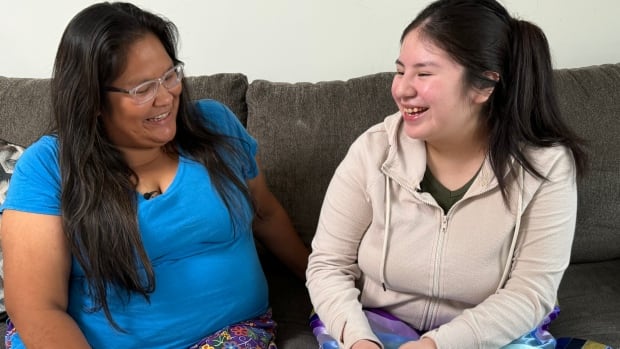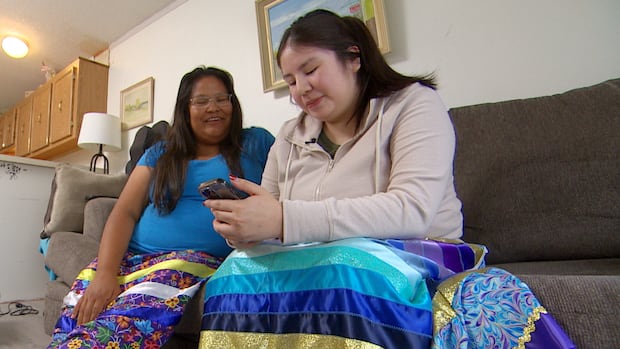It was New Year’s Eve when Tenielle Easter started bleeding. Staff at the nearby hospital confirmed her fears — she was having a miscarriage.
“It was very, very hard and traumatizing for me,” she said. “I didn’t know what to do. I feel like everything just went downhill.”
The experience sent Easter, then 18, into a tailspin — years of recklessness, substance abuse and bad decisions.
When she got pregnant again three years later, she knew things had to change.
“I was just scared that it might happen again, that I would have to go through it again, because it truly is a hard thing. You don’t get over it. You just learn to live with it,” Easter said.
But this time, her community, Opaskwayak Cree Nation, had introduced a doula program, offering pregnant women education and support.
On June 7, Easter gave birth to a healthy baby boy, Taven.
“Most of my pregnancy, it was very hard, but with the support from my family, I got through it. And here I have my son,” she said. “I am thankful for my baby boy.”
Easter’s story echoes those of many women living on remote First Nations in Canada.
While Canadian infant mortality rates have been declining over time, there still is a gap between Indigenous and non-Indigenous populations. Poverty, a lack of housing and quality drinking water, and systemic racism are some of the factors responsible.
A 2017 study found infant mortality rates more than twice as high as the non-Indigenous population. Post-neonatal deaths made up nearly half of all Indigenous infant deaths, compared with about one-quarter of all infant deaths in the non-Indigenous population.
An analysis in 2023 using Statistics Canada data found, in the periods from 2004-06 and 2014-16, infant mortality rates of Indigenous populations were higher than those of non-Indigenous populations by a factor of about 1.8.
Health leaders in Easter’s community, Opaskwayak Cree Nation, have noticed an increase in miscarriages.
“There was really no support for young mothers that were expecting and, as a result of that, there was a lot of bad outcomes, both miscarriages and also babies being born with illnesses,” said N. Glen Ross, executive director of the Opaskwayak Health Authority.
“It caused a lot of mental health problems for young people, young mothers.”
They decided to do something about it.
Using funds from the federal First Nations Inuit Health Branch, community leaders launched a midwifery project. They have also started a proposal for a birth centre.
WATCH | People in Opaskwayak Cree Nation explain why they’re trying to bring birthing home:
What people in Opaskwayak Cree Nation are doing to find solutions to high rates of miscarriages and infant mortality.
Indigenous Services Canada (ISC) currently recommends transfer to a hospital for delivery at 36-38 weeks gestational age, sooner if it’s a high-risk pregnancy, in consultation with a physician or nurse practitioner.
The goal is to bring the traditional midwife back and “get rid of the federal evacuation policy,” said Luise L. Bugera, who manages the Maternal Child Health program for the Opaskwayak Health Authority.
“We need to keep our families together at this important time in life.”
However, trained midwives are scarce and it’s even harder to find Indigenous practitioners, so they were unable to recruit any to Opaskwayak. Instead, they rolled the funding into three doula positions. Doulas provide physical and emotional support to clients before, during and after the birth.
The goal is to train those women to become midwives regulated by the College of Midwives of Manitoba.
Evelyne Fischer is one of those doulas. Easter is her niece, and also one of her patients.
“I feel like I went through that loss with her. We cried, and I remember calling her and telling her that, you know, it’s not her fault,” Fischer said.
“And then when I hear she’s pregnant the second time, I was a bundle of nerves and pure joy — so excited. But I was counting down the weeks.… We made it to 21 weeks, and I’m like, ‘Oh my gosh, baby can be born now.'”
Fischer gave birth to her own son in Winnipeg. Now, as a doula, she sees many sad cases of loss, which is why she believes strongly in the importance of community support and prenatal care.
“They help you through one of the most vulnerable times of your life,” she said.
“If you are invited into that space where a woman is giving birth, you’re invited into a very intimate, raw, vulnerable place. It’s very, very sacred, and just to be included in that space is something very special, and I feel honoured every time I’m asked to be a part of it.”

Opaskwayak’s program includes grocery shopping tours, cooking classes and lectures by dietitians, mentors for women with substance abuse problems and more traditional activities, such as creating medicine and birthing bundles, which include baby ribbon skirts, a breastfeeding pillow, moss bags, a baby bonnet and moccasins.
Transportation and child care are available so there are no barriers to attend. Women are also given fresh vegetables from the community’s vertical smart farm.
This is exactly what First Nations need to do, said Karen Lawford, a midwife and associate professor in the department of obstetrics and gynecology in the midwifery education program at McMaster University in Hamilton, Ont.
“Bring it back to your community. Bring it back to the nursing station. Bring it back to your home. Build a birthing centre,” she said.
Lawford’s research has found Indigenous people conceptualize risk differently from western health-care providers.
“People are actually afraid of dying, not because of their pregnancy or any health related risks to them — they’re actually afraid of dying in the hospital because of negligent care,” she said.

At the same time, physician shortages and the closure of hospitals across Canada have created a maternity care crisis that Lawford said could be easily solved by offering more services on First Nations.
“Imagine a care team with nurses, nurse practitioners, pharmacists, midwives providing comprehensive care across the entire pregnancy, as well as for the new baby,” she said.
“Midwives are primary care providers, so also doing the birth and then diagnosing, watching things. When you don’t have that care in community, you have no caring community.”

In a statement, Indigenous Services Canada said 85 First Nations are receiving funding for Indigenous midwifery initiatives, with projects in various stages of implementation.
“In communities where midwifery services are available, and provincial/territorial regulations allow it, birthing in community is possible in cases where pregnancies are low risk. Some communities also have self-government agreements or agreements with provincial/territorial health systems that allow low-risk deliveries to take place,” ISC spokesperson Eric Head wrote.
Head acknowledged the need for more accessible midwifery training programs and additional primary care nurses in remote and isolated communities.
Budget 2024 proposes to provide $167.6 million over five years, starting in 2024-25, to combat anti-Indigenous racism in health care, support patient advocates, health system navigators, midwives and birth support workers, and increase Indigenous representation in the health professions.
“Everyone deserves to have the health care they need, when they need it. From coast to coast to coast, we are working alongside partners to ensure access to culturally appropriate and safe maternal health services, close to home,” Head wrote.



